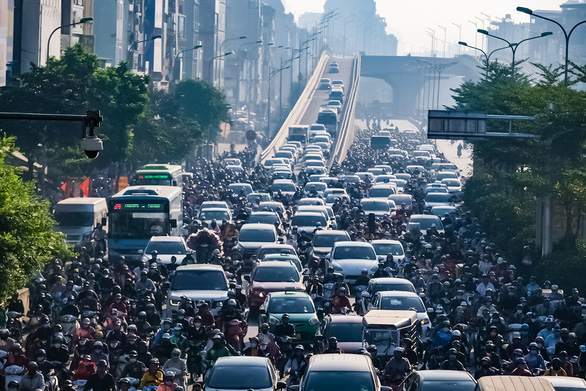The opening of the Nga Tu So - Nga Tu Vong section of Hanoi’s elevated Ring Road No. 2 has exacerbated traffic congestion through the section, which has been happening there during rush hours for a long time.
Opened to traffic on November 9, the new section, which is only for cars, connects two kilometers of road from Nga Tu So Intersection to Nga Tu Vong Intersection as parts of elevated Ring Road No. 2 from Nga Tu So Intersection to Vinh Tuy Bridge.
The route is expected to reduce traffic congestion on downtown roads which are under pressure from heavy traffic in Hanoi.
However, the Nga Tu So - Nga Tu Vong section has appeared to go against the expectation over the past few days.
The flow of cars from the elevated section that ends just right before Nga Tu So Intersection intensifies traffic on both Truong Chinh Street and the busy intersection.
When cars and motorbikes cross the streets, the traffic there becomes chaotic. Oftentimes vehicles have to spend some 15 minutes making it through Nga Tu So Intersection.
Hoang Vinh Thang, a 33-year-old commuter, told Tuoi Tre (Youth) newspaper that before the opening of the Nga Tu So - Nga Tu Vong section, it took him about two to three red lights to cross from Truong Chinh Street through the intersection to Lang Street.
But he now has to wait up to five red lights.
Thang commented that the new elevated route does help reduce congestion at the intersection of Truong Chinh Street and Ton That Tung Street, which is about 950 meters away from Nga Tu So but contrarily overloads the Nga Tu So junction.
Vu Anh Tuan, a lecturer from the University of Transport and Communications (UTC) in Hanoi, agreed with Thang’s opinion, saying that the new elevated section’s ending right before Nga Tu So increases the traffic load on Truong Chinh Street by 1.5 to two times, turning the intersection into a bottleneck.
According to Tuan, traffic congestion at Nga Tu So can be reduced if the elevated Ring Road No. 2 continues about four more kilometers until Cau Giay District before the beginning of Vo Chi Cong Street.
On the other hand, Tuan did not support the idea of building short elevated road sections like the Nga Tu So - Nga Tu Vong, which he thought cannot contribute to easing pressure on traffic networks as a whole.
Elaborating on Tuan’s opinion, Dr. Nguyen Quang Toan, former head of the infrastructure department at UTC, explained that the original purpose of urban elevated roads is to prevent the flow of vehicles passing through the city from entering the city’s inner parts.
It is inappropriate to turn urban streets into elevated roads, according to Toan.
In order to resolve the congestion issue at Nga Tu So, the immediate measure is to reorganize the traffic on the streets leading to the junction, Toan said.
The Hanoi Department of Transport also has plans to apply this measure.
In addition to the adjustment of the traffic light cycle, it is necessary to increase regular traffic control by traffic police officers, the expert added.
Like us on Facebook or follow us on Twitter to get the latest news about Vietnam!


















































